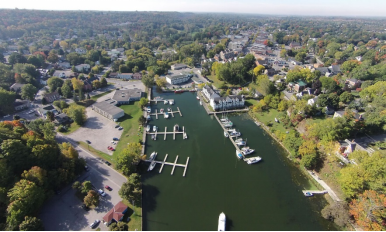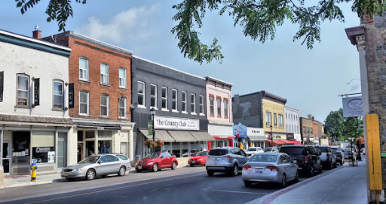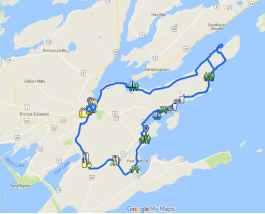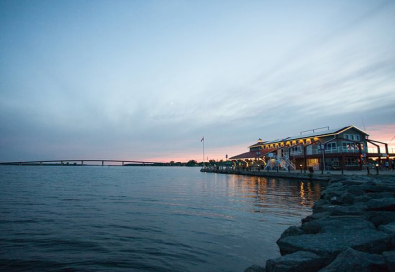Picton, Ontario 作者: 来源: 发布时间:2021-05-25
I.Population and Area
₋Area
Land: 4 km2 (2 sq mi)
₋Population (2016)
Total: 4,702
Density: 931.7/km2 (2,413/sq mi)

II.Natural Geography
₋Picton is an unincorporated community located in Prince Edward County in southeastern Ontario, roughly 160 km (99 mi) east of Toronto. It is the county's largest community and former seat located at the southwestern end of Picton Bay, a branch of the Bay of Quinte, which is along the northern shoreline of Lake Ontario. The town is named for Lieutenant General Sir Thomas Picton, who served in the British Army during the Peninsular War in Spain and Portugal. He also saw action at the Battle of Waterloo, where he was killed. It was formerly incorporated as a town. Picton is home to the Picton Pirates of the Empire B Junior C Hockey League in the Ontario Hockey Association.

₋Transportation
₋Picton Airport is a general aviation airport used primarily for recreational flying. It is also used regularly in the summer season for Canadian Air Cadet flight training using Schweizer SGS 2-33A glider sailplanes and Bellanca Scout 8GCBC aircraft. Highway 33, also known as the Loyalist Parkway, passes through the centre of Picton and serves as its main link to the larger Ontario highway system. It is the main artery from the Glenora Ferry terminal (approximately 10 km (6.2 mi) from Picton) in the east to Carrying Place and the Murray Canal (approximately 40 km (25 mi) from Picton) as you exit the county in the northwest. Proceeding north-northeast from Picton is County Highway 49 which eventually connects to Highway 401 between Greater Napanee and Shannonville, after passing through a portion of Tyendinaga Mohawk Territory. Highway 33 also connects to Highway 62, which provides a link to the city of Belleville, approximately 30 km (19 mi) to the northwest. The city of Kingston, the eastern terminus of Highway 33, is located approximately 60 km (37 mi) by road east of Picton if you use the year-round Glenora Ferry to exit the county travelling east. At one time, Prince Edward County was served by an extensive rail system. However, the railway no longer exists. The former rail beds have been converted into recreational trails which wind around the outskirts of Picton and throughout the County and are used for various purposes year-round. Picton has extensive small-craft docking facilities and boat launch ramps. There are no facilities for heavy shipping at the tip of the bay, so large commercial vessels are generally not seen in the portion of Picton Bay near the town. However, east of town, on the northern shore of the bay, is the ESSROC cement plant which has industrial docking facilities.

III.ECONOMY
₋The average salary in Picton, Ontario is C$18.13. Trends in wages decreased by -100.0 percent in Q1 2020. The cost of living in Picton, Ontario is 100 percent higher than the national average. The most popular occupations in Picton, Ontario are Personal Support Worker (PSW), Registered Nurse (RN), and Apprentice Plumber which pay between C$12.69 and C$30.90 per year. The most popular employer in Picton, Ontario is Sobeys.
₋Website: https://www.payscale.com/research/CA/Location=Picton-Ontario/Salary
IV.Industrial Characteristics
₋Tourism
₋Picton is also located in one of Ontario's popular vacation spots, featuring camping, boating, wine making and upscale lodging. The tourism industry is a primary source of revenue for many area residents, especially in the summer. Historic downtown Picton offers a wide array of shops and services. Sandbanks Provincial Park is located near Picton. The historic Crystal Palace (circa 1890) is one of the last remaining replicas of the original Crystal Palace site of The Great Exhibition. Beside the Crystal Palace is the County Youthpark, another draw for tourists. Recently the YoungLife youth event "Road Rage," which had teens of all ages visiting skateboard parks across Ontario and then entering their home made skateboarding video into a contest, passed through Picton, bringing young blood into the County to visit what is otherwise recognized as a large retirement community. The County Youthpark provides the space for both skateboarders and BMXers to enjoy the park and also provides space for the young and young at heart to enjoy the innovative playground. A canteen is open during the summer to sell small food items. The Picton BIA represents the voice of business and includes the owners and tenants of more than 200 commercial properties in the Town. Its members support numerous charitable activities in the region, including the Picton Santa Claus Parade. Picton continues to serve as the economic hub of Prince Edward County.
V.Attractions
1.Birdhouse City

₋Birdhouse City is a collection of more than 80 miniature reproductions of historic buildings and other recognizable structures from The County and around the world.
₋The collection began when the late Doug Harnes, a former superintendent with the Prince Edward Region Conservation (now Quinte Conservation), re-created the historic Massassauga Park Hotel at a birdhouse scale. Over the years, schools, businesses, individuals and groups have built and contributed more than 80 birdhouses, including reproductions of Crystal Palace, the Merrill Inn, Salmon Point Lighthouse and Roblin’s Mill.
₋Website: https://www.visitpec.ca/business_listings/birdhouse-city/
2.Sandbanks Provincial Park

₋Sandbanks Provincial Park is a provincial park located on Lake Ontario in Prince Edward County near Picton, Ontario, Canada.
₋It is noted for its picturesque sand dunes and beaches. It also has the world's largest fresh water sand bar and dune system.
₋Sandbanks is run by the government of Ontario, with areas for different types of recreation. Some parts of the beach had been bought or settled before the designation of the area as a provincial park, which makes the beaches come in short clusters along the coastline. Naturists have used the beaches for nude bathing for many years.
₋Sandbanks Provincial Park and surrounding beaches are visited by hundreds of thousands of tourists each year. One of sandbanks many beaches is a pet zone, where visitors can bring their dogs. The majority of the tourists come from Ottawa, Toronto, Kingston, New York State, Quebec, and other regions of Southern Ontario.
₋County Road 12 in Prince Edward County, stretching from The Outlet, Ontario to Bloomfield, Ontario, runs through the park.
₋The Sandbanks area of the road was somewhat considerable pasture for cattle. By the mid-1850s, the area was changing dramatically. Farmers cut down 200+ year-old trees to clear the land. They built buildings and roads; and in an effort to free up the land to grow crops, farmers allowed their cows to graze on the dunes. The removal of the dunes' natural vegetation meant that there was no longer plants to keep the dunes/sand from shifting across the landscape, burying everything in its path. By the 1880s, considerable roadwork was necessary. In fact, the West Lake road had to be moved three times in a period of 50 years, as the sand kept on burying it. In 1911 they tried to plant White Willow to stop the sand but that did not work. Cotton woods dot the dunes on West lake, and have helped slow erosion. (2019) with higher than normal water levels, many interior walkways and provincial parkland have flooded. Currently, the shifting sand is under control due to natural forest regeneration.
₋Address: 3004 County Rd 12, Picton, ON K0K 2T0
₋Phone: (613) 393-3319
₋Website: https://www.ontarioparks.com/park/sandbanks
3.Bay of Quinte

₋The Bay of Quinte (/ˈkwɪnti/) is a long, narrow bay shaped like the letter "Z" on the northern shore of Lake Ontario in the province of Ontario, Canada. It is just west of the head of the Saint Lawrence River that drains the Great Lakes into the Gulf of Saint Lawrence. It is located about 200 kilometres (120 mi) east of Toronto and 350 kilometres (220 mi) west of Montreal.
₋The name "Quinte" is derived from "Kenté", which was the name of an early French Catholic mission located on the north shore of what is now Prince Edward County.[1] Officially, in the Mohawk language, the community is called "Kenhtè:ke", which means "the place of the bay". The Cayuga name is Tayęda:ne:gęˀ or Detgayę:da:negęˀ, "land of two logs."
₋The Bay, as it is known locally, provides some of the best trophy walleye angling in North America as well as most sport fish common to the great lakes. The bay is subject to algal blooms in late summer. Zebra mussels as well as the other invasive species found in the Great Lakes are present.
₋The Quinte area played a vital role in bootlegging during Prohibition in the United States, with large volumes of liquor being produced in the area, and shipped via boat on the bay to Lake Ontario finally arriving in New York State where it was distributed. Illegal sales of liquor accounted for many fortunes in and around Belleville.
₋Tourism in the area is significant, especially in the summer months due to the Bay of Quinte and its fishing, local golf courses, provincial parks, and wineries.
₋Website: https://bayofquinte.ca/tourism/
VI.History
₋General overview
₋Picton, originally named Hallowell, was first settled in the 1780s by Loyalists from the Thirteen Colonies. Prior to its incorporation in 1837, the modern-day town of Picton consisted of two separate villages, Hallowell Bridge and Picton, which occupied the opposite sides of Picton Bay. Named for General Sir Thomas Picton, Wellington's second-in-command at the Battle of Waterloo, the Town of Picton has a profound and rich history. It was here that Sir John A. Macdonald managed a law office for his uncle, Lowther P. MacPherson. In 1998, the town and all other municipalities in the county were dissolved and amalgamated into a single-tier municipality, the Corporation of the County of Prince Edward. Each of the former municipalities is now a ward of the county. Picton is Ward 1.
₋Airfield
₋During the Second World War, the United Kingdom came under siege and required training facilities outside the British Isles for the thousands of pilots needed for its defence. Because of geographical similarities to Great Britain, sparsely populated Prince Edward County was considered an ideal location for a Royal Air Force Bombing and Gunnery School. In the summer of 1940, an aerodrome was rapidly constructed and in November 1940, the RCAF moved in and began small-arms training at the facility. In April 1941, the RAF took over the station and No 31 Bombing and Gunnery School was formed. The school was part of the British Commonwealth Air Training Plan and used to train many of the aircrew needed to help defend Great Britain.
₋Following the end of the war, the Canadian Army maintained a training facility at the old aerodrome. It was renamed "Camp Picton" in 1960 when it became a fully operational Army base. In 1966, it was renamed Canadian Forces Base Picton, but this proved short-lived: in 1969, the base was closed down and sold as part of the consolidation and downsizing of the Canadian military. Portions of the base have been divided up and have served many functions, including conversion of one of the newer barracks sections into a hospital (now defunct). Much of the old base housing is currently occupied as rental homes. The airfield is now known as Picton Airport. The original aerodrome facilities were built using different construction methods than most bases built by the Canadian military. The rapid construction meant that the hangars and other buildings were not designed for longevity, although most still remain standing today. The former Camp Picton now serves many diverse functions but the unique appearance of the base makes it a significant, if obscure, historical landmark. Due to its distinctive appearance, the dilapidated airport has been used as a filming location for several productions. External scenes for the made-for-TV film Haven, starring Natasha Richardson, Colm Feore and Martin Landau were filmed there. It also served as a backdrop for the 1993 CBC production Dieppe and was the filming location of Bomber Boys. It also served as the home of the Driver Rehabilitation Centre for the reality television program Canada's Worst Driver in 2005. Many businesses use the facilities, including a hammock outlet, an auction house and, since the late-1970s, the local Air Cadet squadron, 851 RC(Air)CS, Prince Edward. The airstrip is also the host to various motorsports events, such as those held by the St. Lawrence Auto Club, which regularly runs Solo II racing events in the summer months.
VII.Other Information
₋Telecommunications
The Eastern Ontario Regional Network (EORN) installed a fiber optic backbone in 2012 that connects over 11,800 homes and businesses to high-speed Internet. Plans are in place to both increase area coverage and connectivity speeds to 100mbps in many areas. Those areas that are unable to get service due to terrain issues can connect through satellite service.
All major telecommunications service providers are available in Prince Edward County, including Bell, Cogeco, Rogers and Eastlink. Cogeco has currently installed fiber optic cable for top connectivity speeds in the Picton Industrial Park and at the MacFarland Home development property. Visit the Eastern Ontario Regional Network website to check service availability in your area.
Website: https://www.thecounty.ca/around-the-county/about-the-county/infrastructure/
₋Utilities
In the past, electrical services had been managed by the local utilities commission. In recent years, this was eliminated and electrical power is now managed by the central Hydro One, a former Government of Ontario Crown corporation.
VIII.Contact Information
₋Government
Mayor: Steve Ferguson
MP: Neil Ellis (Bay of Quinte, LIB)
₋City Hall
Address: 332 Picton Main Street, Picton ON
TEL: 613.476.2148
Opening Hours: 8:30am - 5:00pm
Website: https://www.thecounty.ca/county-government/
